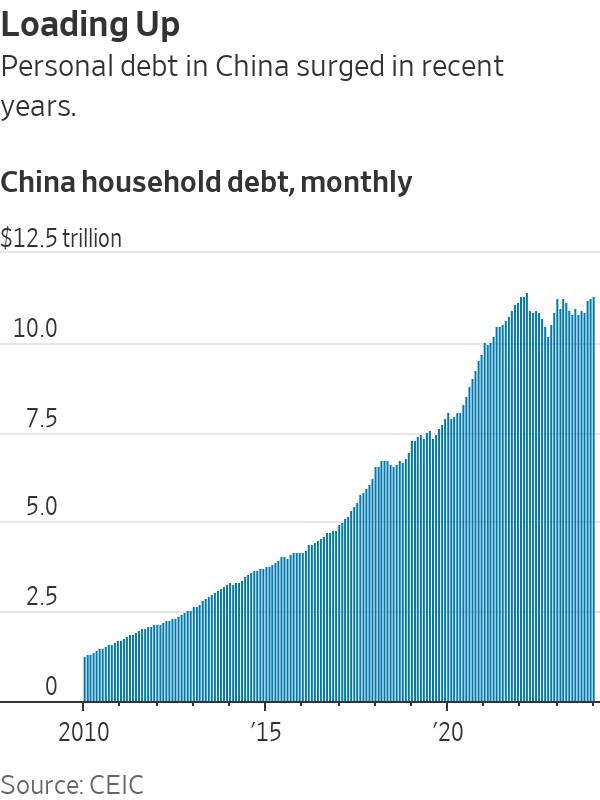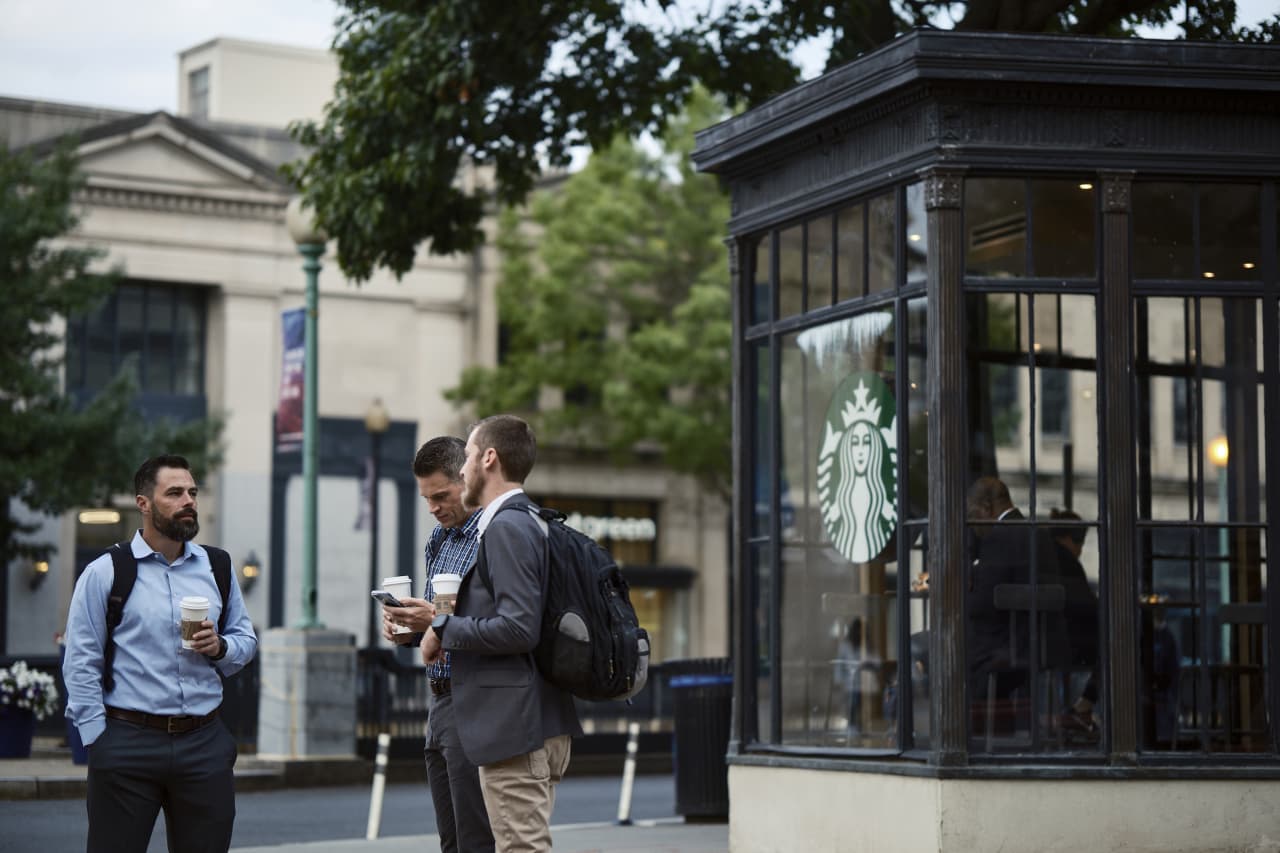China’s Punishment for People With Bad Debts: No Fast Trains or Nice Hotels
Beijing’s crackdown on millions of delinquent debtors makes catching up on unpaid bills a slog
FOSHAN, China—Qin Huangsheng once imagined a better life in the city when she left her home village to become a factory worker at age 16.
Now, in her early 40s, she has $40,000 in personal debt and a base salary of $400 a month. Debt collectors are hounding her. She is blocked from buying tickets on China’s high-speed rail, just one of the penalties the government is increasingly imposing on people who don’t pay their bills.
On the ageing slow trains she is left to ride, Qin sometimes looks at the other passengers and thinks: “I wonder if they’re all bad debtors like me.”
People across China are being weighed down by their debts and a system that penalises them for not paying the money back. Beijing is cracking down on delinquent debtors by seizing their salaries or restricting them from getting government jobs, as well as curbing their access to high-speed trains and air travel. Many are forbidden from buying expensive insurance policies and told they aren’t allowed to go on vacation or stay in nice hotels. Authorities can detain them if they don’t comply.
The number of people on a publicly available government delinquency blacklist has jumped by nearly 50% since late 2019 to 8.3 million today. Courts can put people on the blacklist when they don’t fulfil judgments against them to pay money back or are deemed to be not cooperating with legal proceedings.

Unlike in the U.S., China doesn’t allow most people—including those who had a run of bad luck—to declare bankruptcy to write off bad debts and move on with their lives, a policy some Chinese scholars are criticising as unfair.
Household debt has surged by 50% in the past five years to around $11 trillion today. While that is lower than the $17.5 trillion Americans owe, it is a huge sum in a country where people earn far less.
With home prices falling, deflation risks becoming entrenched and unemployment a persistent challenge , Chinese leaders are eager to get people spending more. But each additional dollar going to pay for debt is taking away one that could be used to splurge on new clothes or pay for a vacation. The threat of punishment for falling behind on debt is making many families more conservative with their money.
Retail sales of consumer goods in China rose 4.7% year-over-year in the first quarter, the government said Tuesday, lagging behind total economic growth of 5.3%. As many in China curtail spending, the government is giving priority to turbocharging manufacturing and exports, a strategy that is exacerbating trade tensions with the West.
With so many Chinese consumers under financial pressure, Western companies including Apple , Estée Lauder and General Motors have reported weaker sales in China .
Chinese officials didn’t respond to questions about the blacklisting system. The government has said previously it only seeks to target those who have the ability to repay their debts but refuse to do so.
Behind China’s personal-debt surge
China’s long housing boom was a significant cause of the rise in personal debts, because many people had to borrow more to afford homes. Some buyers took on extra debt to buy more properties for investment purposes, sometimes letting them sit empty. Now that the boom is over and prices are falling , many are stuck with debts they can’t handle.
The number of foreclosed homes listed for sale rose 43% in 2023 to roughly 400,000 properties, according to real-estate research firm China Index Academy.
The increase in personal debts is also partly a result of more people using credit cards or tapping personal credit lines to handle expenses as the economy stagnates.
Many economists say a U.S.-style financial crisis is unlikely in China soon. State control of the banking system means the government can absorb losses and inject capital in an emergency. Household debts have also largely plateaued over the past two years, as many people give priority to using extra cash to pay down liabilities rather than shopping or investing in stocks.
Still, the prevalence of large personal debts is a problem for China’s leadership.
“Household debt booms tend to lead to bad macroeconomic outcomes, even in the absence of a financial crisis,” said Amir Sufi, a University of Chicago economist. China has no simple fix. “Once the cycle starts, it’s usually one in which it’s painful, long and difficult to predict when it will end,” Sufi said.
A tough system for borrowers
China has tried for years to lift personal spending to ease its economy’s traditional reliance on infrastructure and real-estate growth. Its banks issued tens of millions of new credit cards each year, with outstanding balances jumping 50% between 2018 and 2023 to well over $1 trillion. Private technology apps such as Alipay and WeChat also started helping consumers secure loans as their digital payment systems soared in popularity.
But when debts go unpaid, a person’s income can be seized by the state to cover their liabilities, leaving debtors with a small allowance to scrape by.
A 38-year-old man petitioned courts in the southern city of Guangzhou to raise his monthly allowance to 12,000 yuan, equivalent to around $1,600, from 9,500 yuan to help pay for a newborn child. Judges denied his request late last year, and instead concluded that his allowance should be cut by nearly 40% because he was already getting too much, court records show.
A black market has emerged to serve people on the blacklist. In one case, Shanghai authorities busted a ring of scalpers who were booking high-speed rail tickets on behalf of debtors who were barred from doing so themselves. In early 2021, authorities tracked down a debtor who had been using the service and took him into custody, according to a local court.
The current system gives priority to protecting creditors—often powerful, state-owned institutions—at the expense of helping struggling individuals. Scholars who study the issue say China urgently needs a nationwide personal-bankruptcy system to achieve leader Xi Jinping’s goal of making the country more equitable , by forcing creditors and debtors to share the costs of soured loans.
“A personal-bankruptcy system is a mechanism for the redistribution of wealth,” Li Shuguang, a scholar who has advised the government on bankruptcy policy, wrote in a Chinese magazine commentary online last summer.
Movement on the issue has been stymied in part by opponents who believe such a system would only encourage more people to shirk their debts.
One woman’s saga
For Qin, the former factory worker, easy access to credit backfired badly.
As a 16-year-old in 1999, Qin boarded an overnight bus from her home in rural southern China to the grimy manufacturing hub of Dongguan, north of Hong Kong.
Her parents, who are farmers, couldn’t afford a payment of less than $15 needed for her to take a high-school entrance exam. She vowed to make it on her own, and found work in factories producing slippers and golden jewellery.
A few years later, Qin secured her first credit card. With it, she bought a computer to teach herself to type so she could land a better job.
When the bill was paid, Qin said she tried to cancel the card. “Keep it for an emergency,” the bank clerk told her.
Qin’s career flourished and she eventually moved to the metropolis of Guangzhou. By 2010, she said, she was managing bidding for a company that supplied fire-safety equipment to real-estate projects. Her nest egg steadily grew from the lucrative commissions she earned in the property boom.
When the property sector slowed, she jumped industries. An acquaintance had been involved in a startup that was developing software to help small-business owners collect WeChat data to generate more foot traffic and aid marketing efforts.
Qin said she invested the equivalent of around $150,000 of her savings into the venture.
The startup burned through her initial investment as it tried to get the software up and running. Qin said she then agreed to start putting some of its expenses, including office supplies, rent and employee salaries, on her credit cards, and to tap personal credit lines she had obtained via WeChat and Alipay.
A roadshow by the company was warmly received, she said. But its prospects dimmed after the Covid pandemic hit.
The company’s struggles left Qin with the equivalent of tens of thousands of dollars of debt. Phone calls from debt collectors have become a daily occurrence.
With no option of bankruptcy, Qin concluded that a new job was her only way out of trouble.
“As long as I’m still living and have a life, I can work hard to earn the money back,” she said.
That path has faced unexpected difficulties. In 2021, while preparing for a business trip to Shanghai, more than 700 miles northeast of Guangzhou, Qin realized that she had lost her access to high-speed rail, where a government I.D. is required to buy a ticket. She took the slow train—and later quit that job in part because the travel restrictions were making it impossible.
Local officials didn’t respond to questions about Qin’s case and The Wall Street Journal wasn’t able to verify some details of her account.
Today, Qin is working in a shop in Foshan, south of Guangzhou, selling traditional Chinese medicines. With a base salary of about $400 a month, she has found it tough to put a dent in her debts, but said she has managed to pay back two of her credit cards so far, with about $40,000 still to go.
Qin is trying to stay optimistic, hoping that medicine will be in high demand as China’s population ages, opening the door to bonuses and potentially even running her own shop. Still, she has had to get creative to earn the cash to pay her debts.
Her current role requires Qin to collect payments from customers using a digital wallet on WeChat. But she said that function on her account has been frozen several times since 2022, leaving Qin to seek help from her family.
She decided not to tell her parents about the full scale of her troubles, however.
If they knew the truth, Qin said, they “wouldn’t be able to sleep.”
 Copyright 2020, Dow Jones & Company, Inc. All Rights Reserved Worldwide. LEARN MORE
Copyright 2020, Dow Jones & Company, Inc. All Rights Reserved Worldwide. LEARN MORE
This stylish family home combines a classic palette and finishes with a flexible floorplan
Just 55 minutes from Sydney, make this your creative getaway located in the majestic Hawkesbury region.
People spend a lot of money on all sorts of things, only to later ask themselves: Why?
While it may be true that money can’t buy happiness, that doesn’t stop people from trying.
And then wishing they hadn’t.
Many of us have had a big-ticket expenditure that we later come to regret. Maybe it’s something meant to convey status, which we realise later did nothing of the sort. Maybe it was to fulfil dreams of a luxury lifestyle, only to discover that we’ve bought a bottomless money pit.
We asked Wall Street Journal readers to share their stories of pricey purchases that ultimately led to disappointment. Below are some of their stories and reflections—with some free advice to their younger selves.
The wristwatch of his dreams
“It was back in day of wingtip shoes, white shirts and red ties,” says Bryan Desloge, who began his career at IBM in 1984. And like many rookie employees, Desloge wanted to fit in. “I bought suits. I took my earring out. I cut my hair and I registered in the Republican Party,” he says. To complete the look, he paid over $7,000 for the wristwatch of his dreams—a Rolex Submariner. It was a hefty sum, considering he was making roughly $18,000 a year.
Now 64 and retired, Desloge says his younger self saw the stainless-steel watch as a status symbol. “The older guys had nice dress watches already, while I wore a Casio or a Timex.” Just two years after buying the Rolex, however, Desloge realised the timepiece was impractical for him. “The Rolex is great, but I don’t want to look at a clock face,” he says, “and the glow-in-the-dark hands are hard to read at night.”
Desloge, who lives in Tallahassee, Fla., recently tried to give the Rolex to his son, who turned him down. So it remains tucked away in favor of a Garmin smartwatch, which has a fitness tracker, alerts and email, among other features. Purchased for about $500, the Garmin can multitask in ways his Rolex cannot. “I will probably wear that watch for the rest of my life,” Desloge says.
Cabin fever
The family called it “the little brown house,” says Michael Kotas of his vacation cabin in the mountains overlooking Tucson, Ariz. In 2005, Kotas and his wife paid $120,000 for the 1950s cabin, and it needed a lot of work.
“We bought it from an older couple, who had dark rugs and wood paneling,” says Kotas, who is now in his mid-60s and retired from a job in technology sales. He redid the cabin “with a cool Manhattan vibe,” updated the electrical wiring and corrected a flooding issue in the basement. In all, Kotas estimates he spent $60,000 in upgrades.
But his financial headaches were far from over.
Even though Kotas owned the cabin, the federal government owned the land it sat on, since it was located within the Coronado National Forest. Leasing the land cost $800 a year when the cabin was purchased, but eventually grew to $3,600 a year by the time it sold.
During that time, two fires came within 100 yards of the cabin, jacking up Kotas’s fire-insurance premiums. Then, a species of bark beetle attacked ponderosa pines there, and the Forest Service required cabin owners to remove infested trees around their property, costing $1,000 to $1,200 a pop. “I counted all my trees around my house and thought, ‘I can’t afford this.’ ”
Over time, Kotas’s children didn’t want to go to the cabin anymore, saying “there was nothing to do,” he says. “We ended up spending about five nights a year there for the last several years.” Kotas, whose year-round home also is in Tucson, came to the realisation that he wasn’t getting his money’s worth. “It became an albatross,” he says.
The tipping point came when a man parked his truck just 100 feet from the cabin and lived out of his vehicle on the side of the road. Kotas sold the cabin in 2022 for $195,000.
“I would probably never buy a vacation home again,” he says. “It was a tough lesson to learn. I wish the [new] buyers well, but all I can say is, ‘Good riddance!’ ”
RV to nowhere
After retiring from a career in ophthalmology, Gordon Preecs bought a large pickup truck in 2013 and a 22-foot travel trailer in 2017 with the dream that he and his wife, Connie Preecs, would visit national parks around the country. Combined, the new vehicles cost around $50,000.
Living in Seattle at the time, the couple started out by taking the RV on short trips, such as an event for woodcarvers in Washington state. It didn’t take long for them to feel pinched in a 120-square-foot RV. “I thought we’d have our own hotel” with an RV, says Preecs, who is now 75 and living in Round Rock, Texas. “But we had to just shove things in there. The kitchen counter was hand’s breadth wide, and the bathroom was like a phone-booth shower. If I dropped the soap, I couldn’t pick it up.”
Three years after purchasing the trailer, Preecs and his wife relocated to Texas to be closer to their grandchildren. Still, they were able to visit Grand Teton and Yellowstone national parks in the Northwest. That’s when they felt the financial pinch of RV ownership.
“At 6 miles per gallon and $60 to $80 a night at RV parks, the expenses really added up,” he says. “We found it was an inefficient way to travel.” Some of the RV parks are located in funky, backwater places, he says. And setup and breakdown at every stop became a hassle. “You want to be free, but you’re not.”
In 2020, they sold the trailer, which had less than 5,000 miles of use, and the pickup for a combined $32,000. With the proceeds, Preecs bought a Tesla.
Outfitted and outwitted
As a vintner in California, much of Pam Starr’s work takes place outside among the grape vines. “I live in jeans and winemaker vests, T-shirts and sometimes boots,” says the 63-year-old. “So I can tear my clothes on a vine or get barrel slime on me” and it doesn’t really matter.
A few years ago, a well-heeled friend with an eye for fashion convinced Starr, who lives in Napa, to join her in San Francisco for a meeting with her couturier—a person who creates luxury clothing to the client’s specifications. The friend had told Starr that she wouldn’t have to buy anything, but this particular couturier was very persuasive, Starr recalls.
For example, the couturier held up a gauzy swimsuit coverup with white sequins and said, “You have to wear this swimsuit coverup by the pool.” Starr paid $1,800 for a custom coverup, but later it hit her: “I don’t wear a coverup when I’m at the pool because I’m actually in the pool.” To this day, it has never been worn. Starr says she spent another $1,800 for an off-the-shoulder silk shirt with three-quarter length sleeves.
The quality of the clothing was low, Starr says. “That silk shirt turned out to be my most disappointing piece,” she says. It didn’t clean well, and hasn’t retained its shape. Many of the pieces she purchased haven’t held up well, she says, even though she rarely wears them. “Out of the 15 items I had made for me, I loved maybe three,” Starr says. “That’s more than $20,000 worth of clothes, and I should have gotten more out of them.”
If she could go back in time, Starr says, she would say to herself, “ ‘Listen, Pam. Pick two things and start slowly. If you like them, you can expand into other things.’ ” Also, she would pause to ask herself how often she would actually wear the clothing.
“Because of a friend, I ended up in a couture shop,” Starr says. “In that world, it’s uncharted territory for me. The couturier pulls you in really hard.” Knowing what she knows now, Starr says, “if I needed someone to design a gown for me, I wouldn’t go back there. I would go to a seamstress locally.”
Just 55 minutes from Sydney, make this your creative getaway located in the majestic Hawkesbury region.
Consumers are going to gravitate toward applications powered by the buzzy new technology, analyst Michael Wolf predicts























